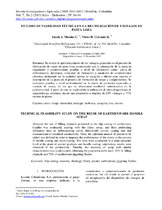| dc.contributor.author | Morales C., Lizeth A. | |
| dc.contributor.author | Colorado R., Víctor H. | |
| dc.coverage.spatial | Seccional Medellín | spa |
| dc.date.accessioned | 2020-12-02T19:26:52Z | |
| dc.date.available | 2020-12-02T19:26:52Z | |
| dc.date.issued | 2013 | |
| dc.identifier.uri | http://hdl.handle.net/20.500.11912/6911 | |
| dc.description | 9 p. | spa |
| dc.description.abstract | Se evaluó el aprovechamiento de los vástagos generados en el proceso de fabricación de orejas de pasta loza, comenzando con la adecuación de la pasta en suspensión y posteriormente pruebas a nivel de laboratorio como: curva de defloculación, tixotropía, velocidad de formación y medición de conductividad eléctrica, definiendo así la cantidad óptima de escayola a utilizar para mejorar el desempeño de la pasta en el proceso de formación de orejas y complementos. Se realizaron pruebas a nivel semiindustrial en la planta de productos especiales y vaciado de orejas, en las que se observaron resultados satisfactorios en la productividad. A partir de esto se implementó la utilización de otros desperdicios de características similares, dando una proporción a emplear de 25% vástagos y 75% recorte de platos. | spa |
| dc.description.abstract | the use of filling channels generated in the slip casting of earthenware handles was evaluated; starting with the slurry setup, and then performing laboratory tests as deflocculating curve, thixotrophy curves, casting rate and measurement of electrical conductivity. Thus, the optimum amount of plaster to be added was defined in order to improve the performance of the slurry in the process of handle casting and drain casting. The tests were conducted in a semi-industrial level at the plant of special products and handle casting; satisfactory results were observed in the productivity. Thereby, the recovery of scrap with similar characteristics was implemented, obtaining the proportion to be used; 25% of filling channels and 75% of earthenware jiggering flashes. | spa |
| dc.format.mimetype | application/pdf | |
| dc.language.iso | spa | |
| dc.publisher | UPB | spa |
| dc.relation.ispartof | Revista Investigaciones Aplicadas | spa |
| dc.rights | Attribution-NonCommercial-NoDerivatives 4.0 International | * |
| dc.rights.uri | http://creativecommons.org/licenses/by-nc-nd/4.0/ | * |
| dc.subject | colaje | spa |
| dc.subject | viscosidad | spa |
| dc.subject | reología | spa |
| dc.subject | barbotina | spa |
| dc.subject | escayola | spa |
| dc.subject | loza | spa |
| dc.subject | recorte | spa |
| dc.subject | Slip casting | spa |
| dc.subject | viscosity | spa |
| dc.subject | rheology | spa |
| dc.subject | Slurry | spa |
| dc.subject | plaster | spa |
| dc.subject | earthenware | spa |
| dc.subject | jiggering flashes | spa |
| dc.title | Estudio de viabilidad técnica en la reutilización de vástagos de pasta loza | spa |
| dc.title.alternative | Technical feasibility study on the reuse of earthenware handle scrap | spa |
| dc.type | article | spa |
| dc.rights.accessRights | openAccess | spa |
| dc.type.hasVersion | publishedVersion | spa |
| dc.description.sectional | Medellín | spa |
| dc.identifier.instname | instname:Universidad Pontificia Bolivariana | spa |
| dc.identifier.reponame | reponame:Repositorio Institucional de la Universidad Pontificia Bolivariana | spa |
| dc.identifier.repourl | repourl:https://repository.unab.edu.co/ | |


